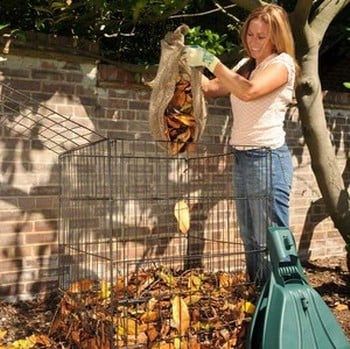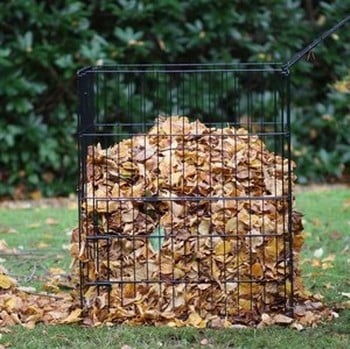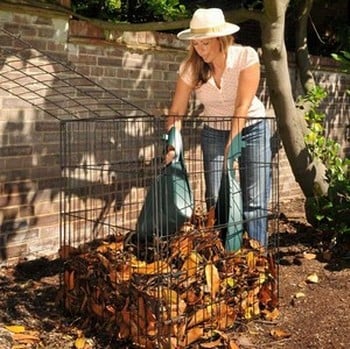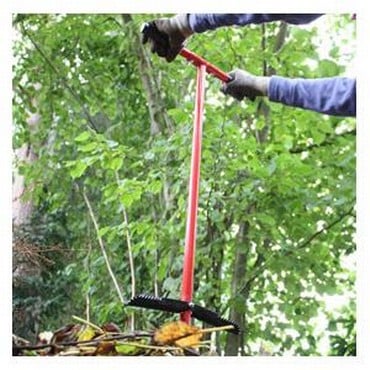Wire Leaf Composter
The Wire Leaf Composter has a rust resistant coating, can hold up to 560 litres and is ideal for storing all those autumn leaves and creating your own supply of nutritious leaf mould
Read More
Don't underestimate the benefits that leaf mould can bring to the garden, and a great way to start making your own free, nutritious supply of nature's very own soil improver is with the Wire Leaf Composter.
The steel wire constructed leaf composter - with a rust resistant powder coating - holds 560 litres and includes a mesh lid with an access door.
- Wire Leaf Compost Bin in powder coated steel
- Easy assembly and with mesh lid and access door
- 560 litre capacity
- Measures 75cm x 75cm and stands 1m high
- Can be easily lined with polythene or weed control fabric if required
Assembly Hints & Tips:-
- The side panels hook into each other easier if held at 180 degrees rather than a smaller angle
- The lid can be bent slightly by hand to allow the hooks to easily slot into place
Product Reviews
I found it much easier than others to construct when I used these instructions from the Gardman website, which frankly should be included with the product. The only tricky part is the lid which is best bent using the rest of the frame as a lever until the hooks pop in. www.gardman.co.uk/.../08661_Wire_Compost_Bin_Instructions_0.pdf
Many thanks for your feedback, sincere apologies that on this occasion the instructions had been omitted from the box.
Lining up the hooks to fit the panels together is very fiddly - in the end it needed two of us and some brute force - but the assembed wire bin is stable. It's good size and because it's open to the elements a tighly packed full bin of leaves settles quickly so we can add more leaves on a daily basis. Looks much nicer in the garden than black sacks with holes in them.
We are delighted with our wire leaf composter. It is of good quality and keeps all our fallen leaves neatly in one area whilst they are composting down. We were pleased to see that there is an access door to remove material from the bottom as and when it is ready. We now wait in anticipation ...
Leaf Mould
There’s no escaping the fact that in the garden, a large part of the autumn is spent clearing up fallen leaves, but there's an upside to all your hard work - leaf mould.
The autumn is a wonderful season to be a gardener. There's a kitchen table-full of fruit and vegetables to harvest, the colours are astounding and the pests and diseases are dying out. It's time to plant winter greens, onions and garlic and your head's full of grandiose schemes and plans for next year.
But there's also the leaves! This subject splits gardeners into two distinct groups - the clear-it-up-as-it-drops-platoon and the-leave-it-to-nature dudes! Collecting fallen leaves keeps the garden looking spotless and also removes potential slug egg-laying sites. The downside? Just as you’ve finished raking one area, the chances are the wind will blow and you’ll need to start again. But don’t see this repetitive work as a chore, because the hard work that goes into collecting these leaves will eventually pay off.
Alternatively, the let 'em rot philosophy follows nature's law to the letter and the fallen leaves will eventually break down where they lay and replenish the soil in a wonderful cycle. But are there other places in the garden more deserving of this natural fertiliser?
Both parties are agreed on one thing. Leaf mould - however and wherever it is made - is beneficial to the garden. Why?
- Easy to make and use
- It's a great alternative to peat
- When used as a mulch it cuts down on watering and water loss
- Can be used on the lawn as a conditioner
- Suitable for adding to potting compost
- And it's free!
Making this valuable mould could not be easier! Just collect up the fallen leaves (all types are suitable), add to a suitable container - a compost bin fits the bill - and water if dry, then leave them for a year or two. There's no quick fix composting aids you can use to speed up the process as it's the action of fungi, as opposed to the composting mainstays of bacteria and micro-organisms, which break down the leaves to form mould. And the fungi like to take things slowly!
Anything else you should know? Chopping or shredding the leaves will help speed up the process slightly (running a mower with grassbox attached over leaves on the lawn is favourite) and it's best to leave some leaves - they provide valuable hiberation sites and bedding for garden animals.
































